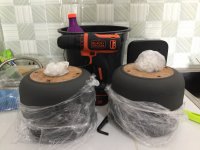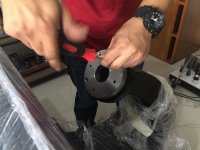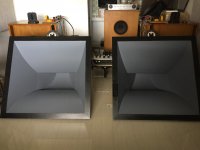A friend also preparing the coil for the two way 300 hz crossover (JBL 2482 (16 ohms) and Altec 416 8B (8 ohms)
View attachment 638839
Such textbook-standard crossover values NEVER work very well with real drivers.
It would be a shame to impair the performance of this potentially very fine system by limiting yourself to such bog-standard formulas.
I advise measuring the unfiltered response first, and then designing a proper passive crossover aiming for the actual acoustic transfer functions.
Marco
Ha ha! I've had a couple of small phone horns and have always wondered what a really big horn and a mobile phone would sound like. Now I know. 😀 Thanks for that.
Norelco, we've discussed this before and I also agree 100% with Marco - that is not even a good starting place. Unless you just want the most basic, not adapted, thing you can get. There is no need to waste money on such a crossover.
You'll need to measure, measure, measure and then use software to figure out your crossover. There is plenty of good measurement software available for free, and a decent measurement rig isn't expensive. You owe it to yourself and to the horns.
You'll need to measure, measure, measure and then use software to figure out your crossover. There is plenty of good measurement software available for free, and a decent measurement rig isn't expensive. You owe it to yourself and to the horns.
thanks Marco & Pano for the information and suggestion, i will do some research on how to do it, any suggestion regarding the software?
REW is the software to get, but it can be a little tough to learn. There are plenty of people to help with it, tho. REW (room EQ Wizard) runs on Windows, MAC and Linux. HOLMImpulse is also good by no longer supported. It's easier to learn than REW and has some nice features. Windows only. ARTA is very nice, but not free except in demo mode.
For the crossover work you can get XSim which was written by Bill Waslo, a forum member, or Jeff Bagby's PCD which runs in Excel. There are others, but those are the ones I use.
For the crossover work you can get XSim which was written by Bill Waslo, a forum member, or Jeff Bagby's PCD which runs in Excel. There are others, but those are the ones I use.
If you want to splash out a little cash, you should look at this package deal.
Dayton Audio OmniMic V2 and DATS V2 Speaker Measurement Bundle
OmniMic is also by Bill Waslo and the WT3 is a super fast way to get the impedance measurements that you'll need to build an accurate crossover.
Dayton Audio OmniMic V2 and DATS V2 Speaker Measurement Bundle
OmniMic is also by Bill Waslo and the WT3 is a super fast way to get the impedance measurements that you'll need to build an accurate crossover.
I have both DATS and rew with minidsp microphone, this three together they solve a lot of measurement problems! Minidsp itself is also good for sketching out ideas for crossover design and hearing them. I have built a 6 way horn system with them, and they sufficed. I plan to build a kind of sato horn this winter! not because I am looking to replace my system but I want to hear this design and I love building 🙂 Congrats to you with your new horns!
Very cool. thanks for sharing.
Until you fabricate your support... bungee chord and duct tape that thing!
Until you fabricate your support... bungee chord and duct tape that thing!
Hi Norelco.
Nice to see your Sato with your JBL 2" throat.
One question; how did you tech-solved the (smooth) transition between Sato-throat-(square)-2" with the JBL-(round)-2" ?
Karel
Nice to see your Sato with your JBL 2" throat.
One question; how did you tech-solved the (smooth) transition between Sato-throat-(square)-2" with the JBL-(round)-2" ?
Karel
Hi
This photo will explain your questions regarding the translation between the throat and the driver.
Thanks,
View attachment 654967
But that's no gradual transition, it's just a plain extension ring.
There will still be an abrupt round>square change of cross-section at the horn throat, with a concomitant disruption of the expansion law... not good...
Acoustically Abrupt
The transition is acoustically transparent only until signal wave length becomes comparable to horn throat (and transition) dimensions; then diffraction will become acoustically apparent in system response at these and higher frequencies. This is also true for passage thickness in the horn neck bend as well. WHG
But that's no gradual transition, it's just a plain extension ring.
There will still be an abrupt round>square change of cross-section at the horn throat, with a concomitant disruption of the expansion law... not good...
The transition is acoustically transparent only until signal wave length becomes comparable to horn throat (and transition) dimensions; then diffraction will become acoustically apparent in system response at these and higher frequencies. This is also true for passage thickness in the horn neck bend as well. WHG
Last edited:
- Home
- Loudspeakers
- Multi-Way
- Western Electric 15A Small SATO horn






